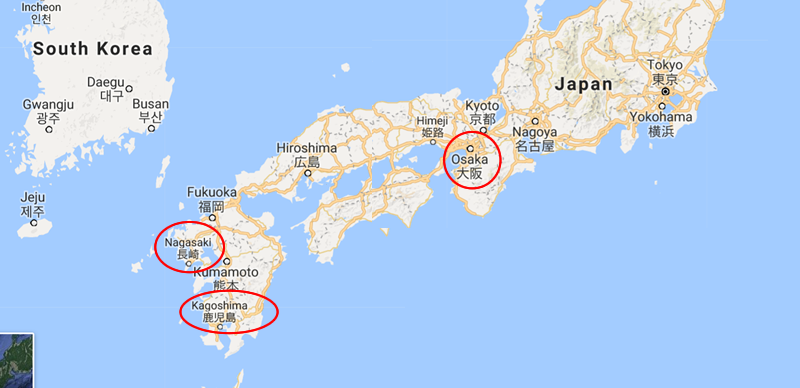Japan
The information about Japan will all be on this one page. Destinations are represented below.
I forgot to mention that right after we left Guam we crossed the Marianna’s Trench when we had 6 miles of water under our keel. One of our prior speakers remarked that it is a wonder that Guam does not fall into the trench… I wondered whether if I dropped a brick into the Trench if due to water pressure it would reach the bottom intact...
Japan - overall impressions
Japan
There are only 14,000 years of history in Japan...I will skip most, just enough for some background.
The next to most modern period, the Edo period, began in 1603 and lasted until 1868. This followed a 100 years war in which various war lords battled each other. The Edo period marked the time when the Shoguns were the real power, although the emperor remained the titular head. Incidentally, the present emperor is a descendant of 2000 years and 25 generations of his family being emperors.
During the Edo period, Japan was under the rule of the Tokugawa shogunate and the country's 300 regional daimyo (lords). It was characterized by economic growth, strict social order, isolationist foreign policies, a stable population, popular enjoyment of arts and culture, recycling of materials, and sustainable forest management. It was based on the principles of complete utilization of finite resources. [Former is abridged and edited from Wikipedia]
The modern period in Japan started with Commodore Perry who, ignoring the one port, the man made island in Dejima in Nagasaki Bay, where foreigners were permitted, sailed his 5 ship "Black fleet" into Tokyo Bay and demanded an audience with the Shogun. This was refused - after all we were barbarians. A show of firepower was made by these ships with a threat to shell Tokyo. He got his audience. What he wanted was a port for our whaling ships to get refurbished. What the Japanese wanted was to be left alone... This incident, despite about 80 years or cooperation with the U.S. and Britain is part of the background for the day that shall live in infamy.
The above incident gave rise to what is called the Shuseikan project when the head of the Satsuma clan felt threatened by Western Powers as he watched them colonize Asia. (More about this project in Kagoshima.) It also caused a civil war in Japan with those who wanted to modernize on one side and those who wanted to maintain isolationism. The outcome came on May 3, 1868 when the Emperor was restored to power, the warrior class lost status and the race to modernize was started in full. This was known as the Mejii Restoration.
To speed quickly through WW II, the Japanese built their naval strategy on winning one decisive battle, much as they had in the Russo-Japanese War of 1904-5. As such they gave short shrift to defensive measures. Additionally, they planned for Pearl Harbor to result in a treaty with the U.S. whose people they thought, had no will to give up their comfortable life and fight a war.
Fast forward to our occupation. Although MacArthur had many faults including an oversized ego, he was a blessing to Japan. When the terms of the unconditional surrender were being negotiated, he understood the need for the Japanese to keep their emperor, and was successful in preserving the Chrysanthemum Throne. He became a very able civil administrator guiding Japan to a constitutional government, directing rebuilding, and helping Japan to again become a nation, but one oriented to peace. My Japanese colleague on this trip, is effusive in her praise of what MacArthur did for Japan.
There is so much to Japan. The Expressways are all toll, but are very well maintained, and connect all Japan’s cities. This appears to be a very prosperous country. There is limited land area for residences due to 70% of the country being mountains. Japan is about the size of California and has a population of 126 million with only 3% of the country being available for residences. 35% of the population live in Tokyo and 26% of the population is over the age of 65. Marriage occurs late – 30 for women and 32 for men and there are many who do not want to get married. Until the 1980s most marriages were arranged, often by a boss or bosses who “encouraged” certain pairs.
Religion is not important in Japan. However, it is said that one is born Shinto, married Christian (more on that later) and buried Buddhist. Shintoism was their original religion. It’s main precept is respect for family and ancestors and worship of natural objects such as trees, water, etc. Shinto shrines are often not in buildings, but just an altar with a view of something natural. Their color is orange which is believed to ward off evil spirits. Buddhism came to Japan in 553 AD. It originated in India, but came to Japan from Korea. It is not unusual for people to say that they are both Buddhists and also practice Shintoism, even the Christians will say that they are Shinto too. Their code of ethics is not religiously based, but comes from a sense of honor, self esteem and a desire to not embarrass the family, and is very strong.
This is a safe country. There are 6 assaults per year here compared to 400 in the U.S. 167 burglaries compared to U.S. 1,099. As counter productive as it seems, this is attributed to the largest organized crime organization in the world, the Yakuza, who work with the police to stop the petty crimes. The Yakuza believe that petty crime gives crime a bad name. Ok, go figure, but it creates very safe streets.
This is a very clean country! The only place that I saw trash on the road was in Kyoto near a McDonalds. And their toilets! Many of them have heated seats – which in a cold park is welcome. (I don’t know if they are cool in the summer…) There are many buttons – one washes the bottom, sometimes even a drier. The hardest one to locate is the flush button! For us Westerners use to no-nonsense toilets, they were confusing. The guide to using them is never to push a button unless one is sitting down. Our guide, an American who married a Japanese and has lived in Japan 40 years said that after WW II the Japanese were prohibited from developing the military so instead developed consumer goods. interesting, they still do not have much air conditioning in homes despite a hot, humid summer.
As far as I can make out, and it is confusing, the written language consists of three different systems and there is an alphabet of 52 syllables which can be used to make words. These are most often used for foreign words. Then there is another alphabet character system of syllables that are more common to Japanese. Lastly there are the Kanji characters, 5000 of which must be known by high school graduates. And some of these characters can have different meanings depending on the context. It is not uncommon in writing to combine the different systems.
In many places, architecture seems to be a mixture of the old style and modern. What all apartment houses have are balconies. Although most apartments have modern washer-drier combinations, the Japanese believe that hanging clothes outside to dry is better. For this reason the weather reports always give the "drying conditions" along with the pollen count.
After the war there was a great need for rebuilding and this took many trees. To replenish this the government encouraged the planting of cedar trees because they grow relatively quickly. However, these trees give rise to cedar pollen season which is now. I too was affected. Many Japanese wear masks, whether to prevent illness, or at this time of year to prevent the pollen or other pollutants from entering their lungs, is not always known.
This is an extremely clean country. Many taxi drivers and commercial bus drivers wear white gloves. The taxis are always sparkling clean. One takes off one's shoes on entering a Japanese home and wears the slippers provided. But, to go to the bathroom, there are separate slippers. And the toilet is never in the same room with the shower. As a nurse I could not help but wondering if their fetish with cleanliness results in a lower infection rate than in the U.S.
The beautiful busses all have seat belts, and by law one is suppose to fasten them. However, one side of the bus has a jump seat which can be put down in the aisle, effectively blocking any egress from behind. We also saw these in the little buses in Majuro and we used them...
As anyone who has tried to communicate with a Japanese knows, they are very vague... They avoid confrontation and instead of saying "no" say, "Let me think about that." Direct communication that we favor is seen as rude by the Japanese.
The climate here is unusually cold this year - but here on Honshu island, it is hot and humid in the summer without much air conditioning. Heating is often a portable fireplace which you carry from room to room.
There is so much more, but time is limited if I am ever to get this posted. Suffice it say that I found Japan wonderful and intriguing and would love to spend more time here.
Osaka Feb. 12 & 13
As we approached our port in Osaka we were welcomed by a fireboat salute, with water of all colors! I didn't have my camera with me, sorry. After going through customs - a rather lengthy procedure, we boarded a bus for Kyoto where we spent the day. the second day we traveled to Nara. But we experienced Osaka at the port area at night.
Osaka is the capital city of Osaka Prefecture and the largest component of the Keihanshin Metropolitan Area, the second largest metropolitan area in Japan with over 19 million inhabitants. It lies at the mouth of the Yodo River on Osaka Bay. They measure their population by daytime, which includes the commuters and nighttime, which is residents only. Historically a merchant city, Osaka has also been known as the "nation's kitchen" and served as a center for the rice trade during the Edo period.
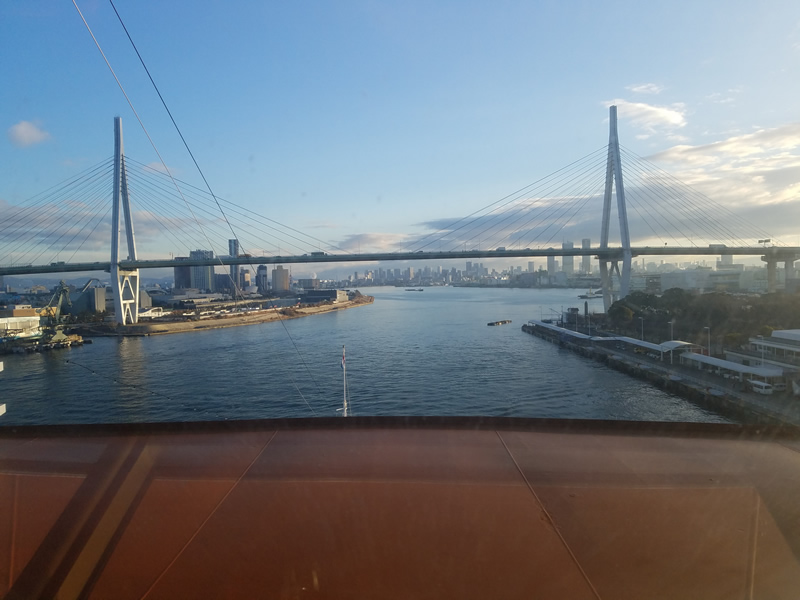
View as we sailed into port in Osaka
Bullet trains arrive her very frequently from Tokyo. We did not tour at all in Osaka, due to limited time. We were moored next to a giant Ferris wheel which finally the last evening I had a chance to ride. The night ride was beautiful. There is a shopping mall of sorts near the port and the lights outside were phenomenal.
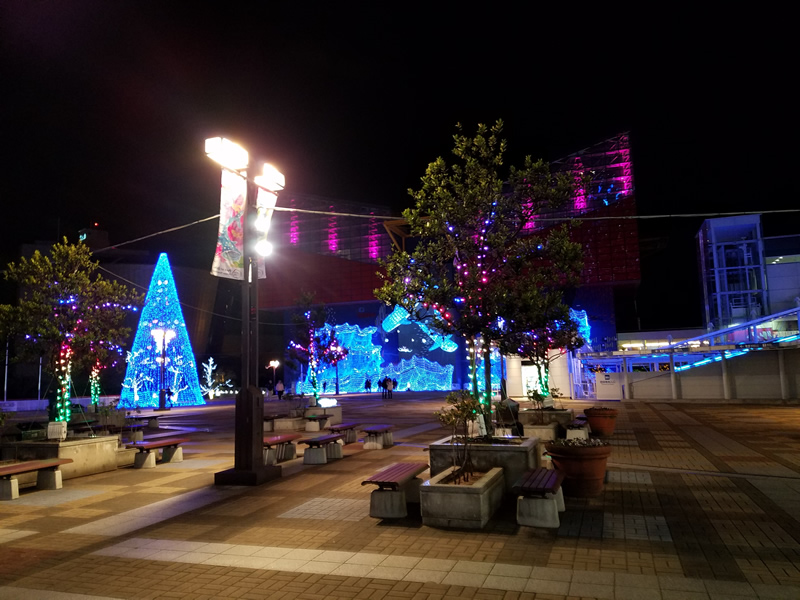
Beautiful - This picture does not begin to do justice to the plethora of lights. This is just one small part.
Must add, there is a legoland near here and there is a huge giraffe made of legos!
In 1927, General Motors operated a factory called Osaka Assembly which until 1941, manufactured Chevrolets, Pontiacs, Oldsmobiles, and Buicks. It was operated and staffed by Japanese workers and a Japanese manager. The nearby city of Ikeda in Osaka Prefecture is the headquarters office of Daihatsu, Japan's oldest automobile manufacturer.
During World War II, Osaka came under air attacks in 1945 by the Army Air Forces. On March 13, 1945, a total of 329 Boeing B-29 Super fortress heavy bombers took part in the raid against Osaka. According to an American prisoner of war who was held in the city, the air raid took almost the entire night and destroyed 25 square miles (65 km2) of the city. The U.S. bombed the city again twice in June 1945 and again on August 14, a day before Japan's surrender.
Kyoto
Kyoto is the cultural capital of Japan and the goal of our first trip from Osaka. It is a modern city, despite NOT being bombed during WW II. Near the end of the war it was considered as a site for the atom bomb drop for two reasons. One, it is surrounded by relatively flat land which would enable the shock wave to penetrate further. Two, the allies believed that it housed many intelligent people who had influence in Tokyo. Much as a German general refused to destroy Paris, Henry L. Stimson, Secretary of War, stood adamant against destroying this city with all its ancient artifacts. For this latter reason and the fact that there was nothing there of value militarily it was spared from the atomic bomb and was not the target of much bombing.
Kyoto was the Imperial capital of Japan for more than one thousand years, until the end of the Edo period when the capital was moved to Tokyo. In the Onin War of 1467-1477 battles between samurai factions spilled into the streets, and came to involve the court nobility and religious factions as well. Nobles' mansions were transformed into fortresses, deep trenches dug throughout the city for defense and as firebreaks, and numerous buildings burned. The city has not seen such widespread destruction since. When Kyotoans talk about the last war, this is the war to which they refer!
As a result, Kyoto is one of the few Japanese cities that still has an abundance of prewar buildings, such as the traditional townhouses known as machiya. However, modernization is continually breaking down the traditional Kyoto in favor of newer architecture, such as the Kyōto Station complex. In 1997, Kyoto hosted the conference that resulted in the protocol on greenhouse gas emissions that bears the city's name.
Our first visit was to the Nijo-jo Castle a former Shogun residence and the only one left today. It is very ornate! Japan puts money into keeping these national and indeed international sites in good repair. The castle had an "early warning system." Called the Nightingale Floor any movement over it created a whistling sound. This was done purposely, but was possible because, like all the castles and temples, the castle was made without nails. (They had none!) And, it still works!

View of arch
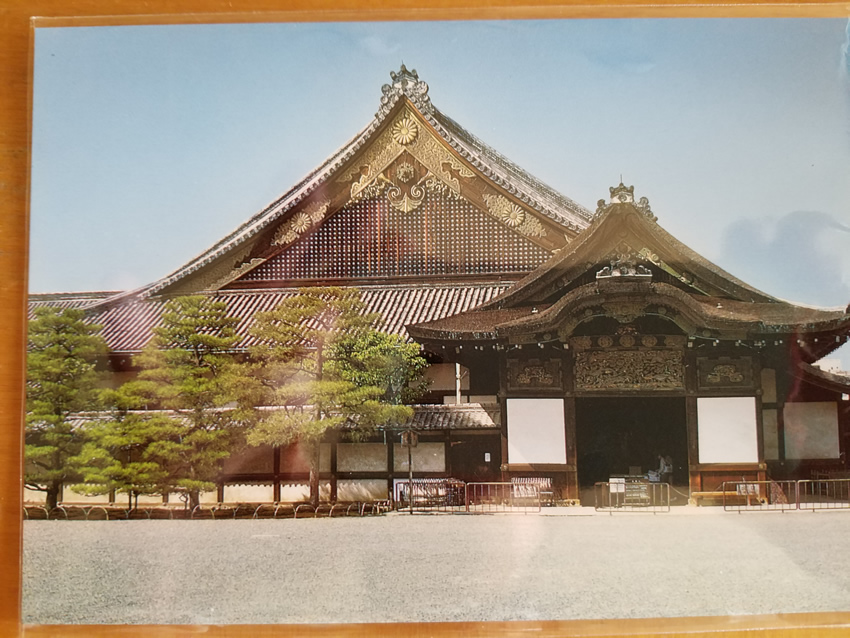
Kyoto Nijo-jo Castle
After this visit, we had lunch at the Kyoto ANA Crown Plaza. What a beautiful lobby! And a huge buffet, that afforded many different taste experiences. Best meal that I have had in ages.
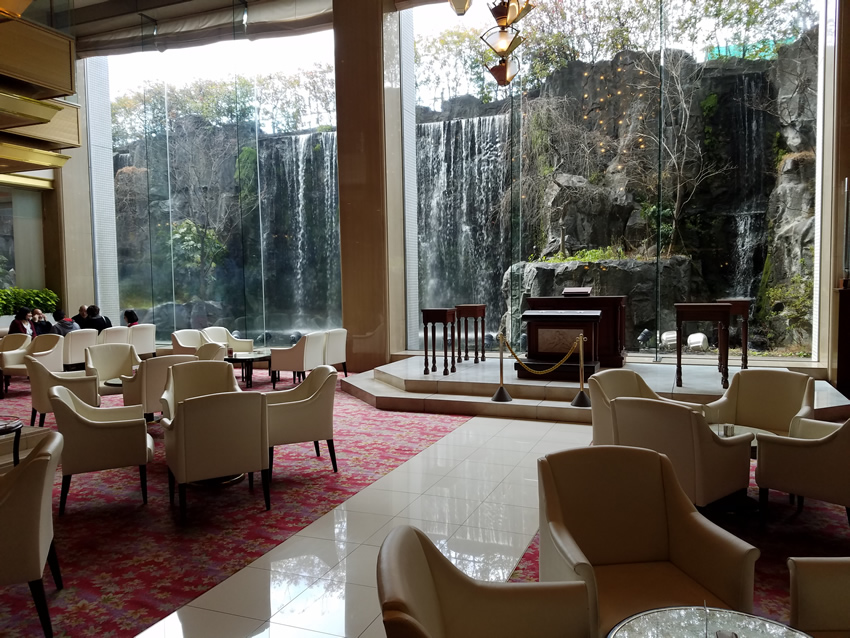
After that we had a lecture on Noh theater. It is extremely difficult to understand and involves wearing masks and a lot of different characters. It was for the nobility and I suspect that even they had a hard time understanding, but of course one had to pretend. As you can tell, it was not my cup of tea, but some did enjoy it.
Then we went to the Golden Pavilion. This was built by the third Ashikaga Shogun as a lavish retirement villa. And it is lavish. Besides the main building there are gardens which are mostly ponds and rocks as is typical of a Buddha garden. It is well worth a visit.

Nara
This was our second day trip from our port in Osaka. If one were to describe this town in one word it would be "deer." they are sacred in Nara and there are 1200 in the parks. We first ran into them at the Toda-ji Temple which houses the largest statue of Buddha in the world. It is covered in bronze and is 45 feet tall. Remember Buddha is always sitting down. As one wag said, "I'll be back when he stands up..."
This Buddha is housed in the Todai-ji temple. To get to the temple, one has to first climb many narrow steps. At the top on either side are statues carved into the sides. Then one descends the same number and type of steps which of course have no guard rails. 
Entrance to the castle proper
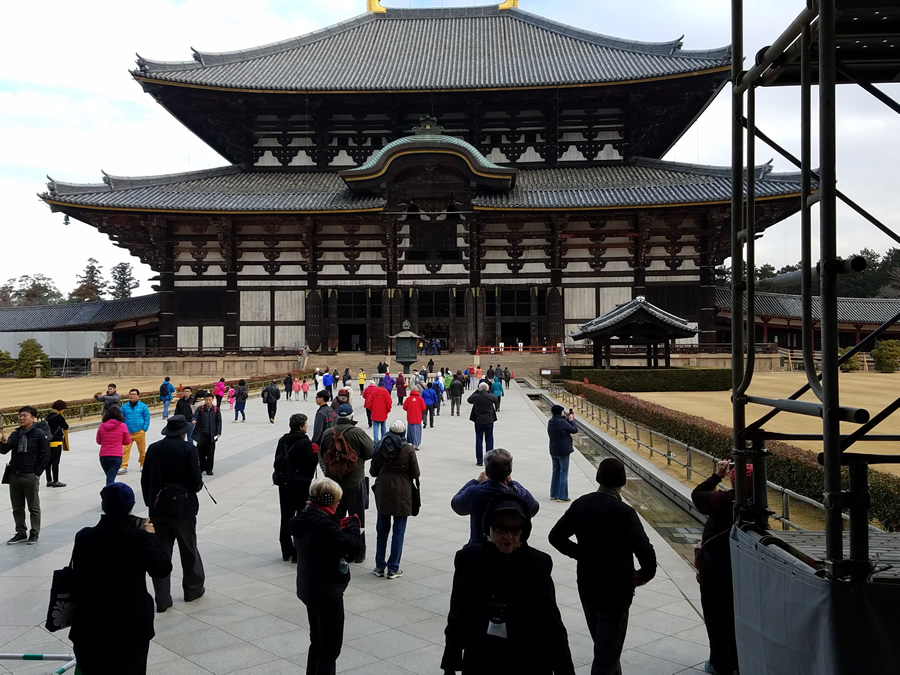
Above is the castle outside, which is 1/3 the size of the original. Like so many things in Japan, it was often destroyed by fire. The fire destroying the original was set intentionally by an angry monk. But rebuilt.
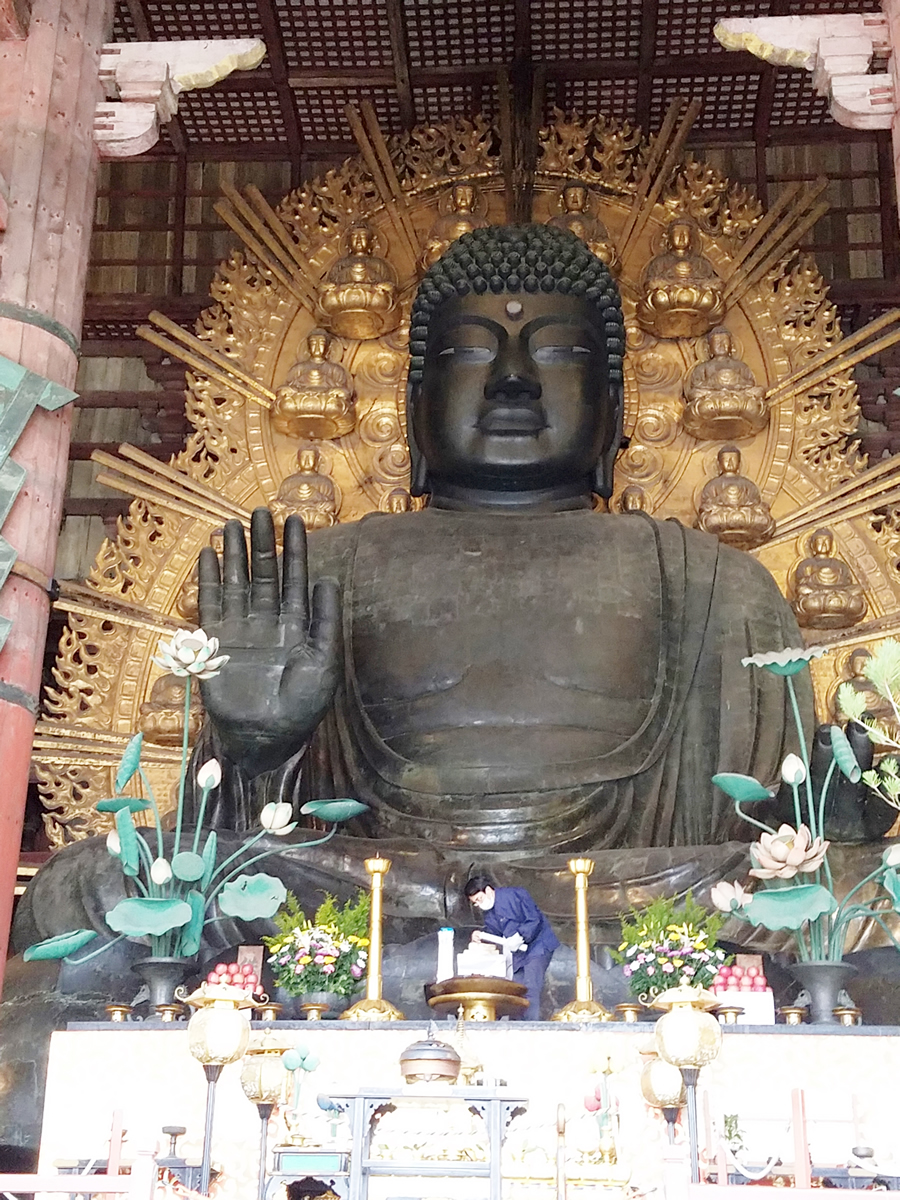
The figure in the front is a monk. The upright hand is suppose to indicate, "do not be afraid." It is said that each nostril is large enough for a man to enter. However, in the temple in another location is a pillar with a hole the size of one of Buddha's nostrils, through which some people can get through, mostly by pulling themselves. We watched a few, who were goaded by their friends amid much laughter.
As you entered the Temple, there was incense burning. Worshippers would light a taper and proceed to the altar to worship. Our Japanese guide said that she comes to this temple every New Years Day. In Buddhism, bells do not have a clapper. Instead there is a wooden "club" on a string which is used to strike the bell. On New Years Eve, the bell is struck 108 times.
Our next visit was to the Kasuga Taisha Shrine, a Shinto place of worship. It dates back to 768 when four deities were invited to reside here on the sides of Mount Mikasa. Like all shrines it is mostly out doors. Each shrine is an orange arch, through which one sees a forest or another natural feature. Before worshipping at a shrine, one has to purify oneself with water from a provided trough. One uses a long handled dipper that is provided to take water out, then washes the right hand, then the left, then cups some water in their hand to wash out their mouth, spitting in another trough. Then the dipper is held with the handle down and the remaining water flows out through the hollow handle.
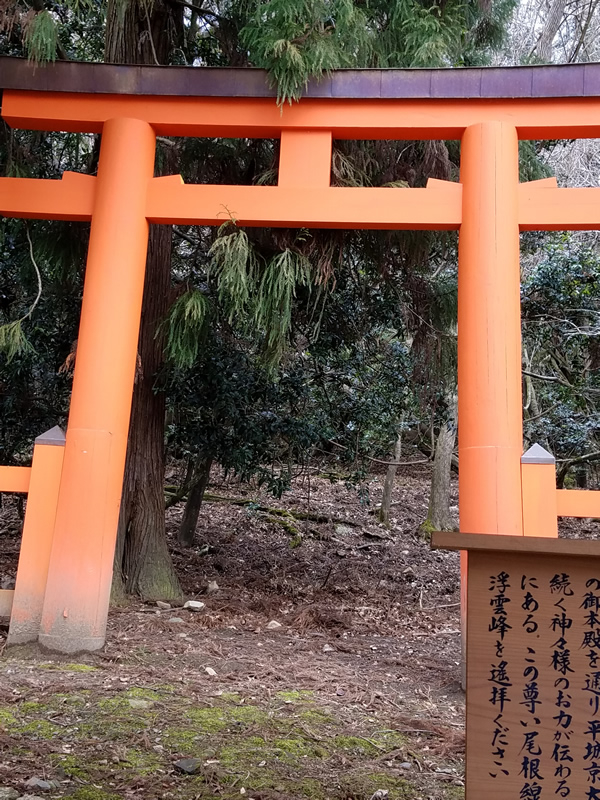
A distinctive feature of this shrine is a lantern lane through a primeval forest that is lined with 3000 lanterns. They are lit during ceremonies by the candles inside.
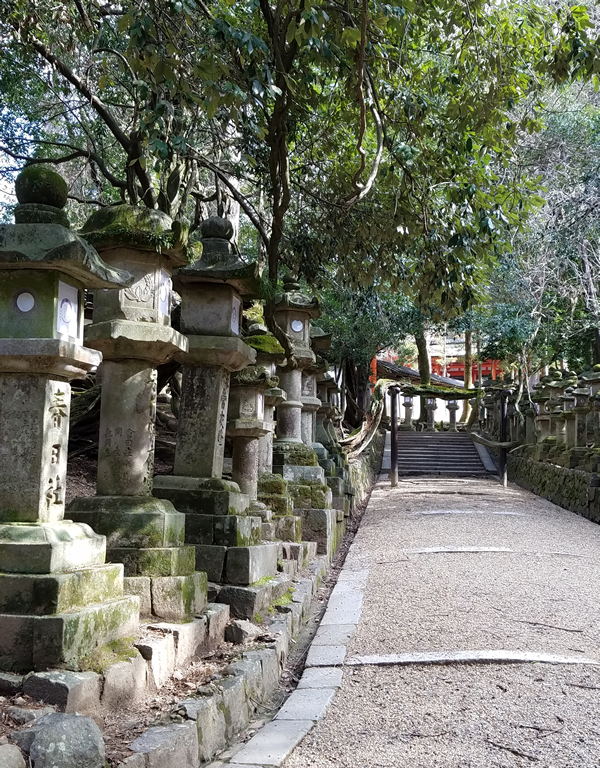
As might be expected, the grounds here are beautiful, even in February. They are having an unusually cold winter, and there was snow on the top of one of the open sided thatched roof huts. We were extremely lucky to be at the shrine as a wedding was being conducted. There is a three sided building for this purpose and I regret that we could not take a picture. Although most Japanese wear white elaborate kimonos, this bride had on a brightly colored one. This wedding ceremony takes several hours and features the bride and groom each drinking 3 cups of sake. The two witnesses, a male and a female, were sitting on a backless bench, dressed in dark suits with their backs to us watching the ceremony. I could not help but think that they must be cold!

The wedding ceremony, held in this structure is a tradition imported from the West. Prior to the war, generally a marriage occurred when the bride's family delivered the bride to the groom's family. This event was celebrated by a party. It was the emperor who first had a wedding ceremony in the late 1800s so it became the custom. This first ceremony was held in Kyoto, as were all the royal weddings until last one which was in Tokyo. This is what I meant when I wrote, married "Christian."
Lunch in Nara was a traditional Japanese dish a hot pot.
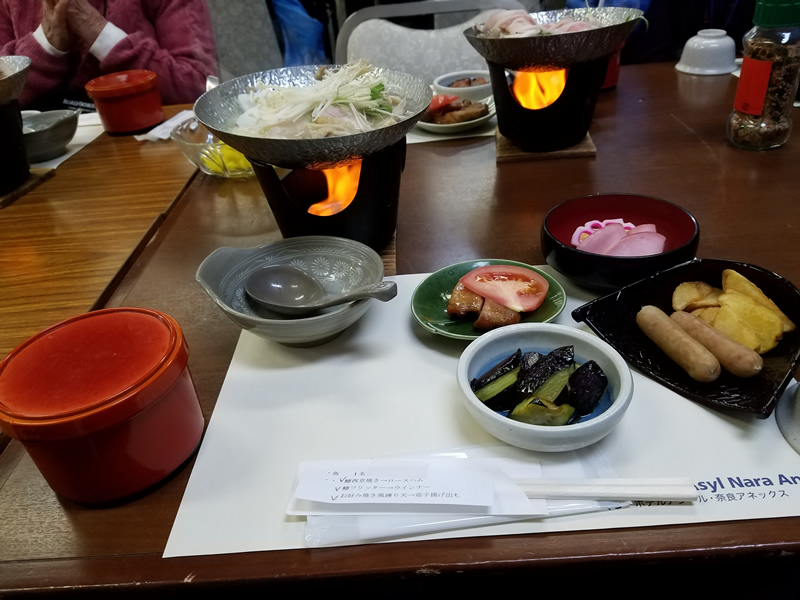
The food is cooked in that pot, after the fuel burns out it is assumed to be cooked at which time one moves it to the soup bowl you see on the left side of the picture. The container to the left contains rice. This is a typical Japanese home dish, and can be made with many different flavorings of the stock. However, in homes there is one big pot and one uses not only the spoon, but chopsticks to move the food to the soup bowl.
After lunch we traveled to Horyu-ji the world's oldest surviving wooden structure and like most other things we have seen, a UNESCO World Heritage Site. It is a 5 story pagoda, built by a prince. A pagoda is a placed of worship. There are many buildings here, but the pagoda is the main attraction. Unfortunately, no doubt due to its age, one cannot enter the pagoda. You cannot see them in the picture below, but the pillars to the upper floors have dragons going both up and down carved around them.
Because it is so damp in the summer in Japan, to prevent rot a feature of all these wooden buildings is pillars that support the building are all on stones. These buildings are maintained and in some of the pillars one can see where parts of the pillar have been replaced due to rot.
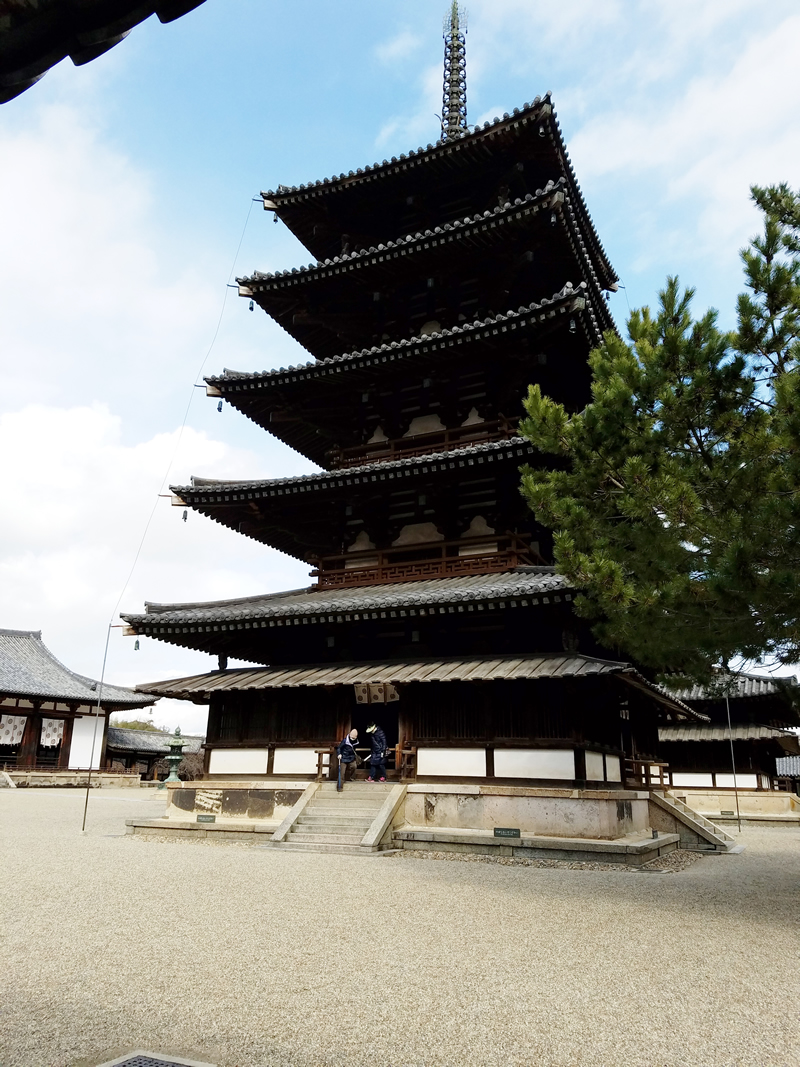
Kagoshima - Feb. 15
Kagoshima is on Kyushu island which is the southern most island of the 4 main Japanese islands. It is not truly an island any more. In 1914, the active volcano Mt. Sakurajima erupted and spilled enough lava to make it possible to connect this island to Honshu. Here it is usually warmer than other parts of Japan and we found a very pleasant, blue sky, warm sun and temperatures in the low 60s, a relief after Kyoto and Nara.
The island is dominated by Mt. Sakurajima, an active volcano rising above Kinko Bay facing Kagoshima. It frequently spews ash and smoke into the sky and the surrounding city. At the park we visited, Sengan-En Gardens, we saw a station for the collection of bags of ash that citizens have to clean up after such an eruption. Our guide said that it had not erupted in 7 months and they were getting a little scared. Then she added that there are people monitoring the tremors and are prepared to warn the population if any serious eruption threatens.
Kagoshima was once known as Satsuma and was the home of one of the most powerful samurai clans, the Shimazu. It was here that the modernization of Japan began even before the end of the Edo period.
Satsuma in the late 1850s could see what the Western Powers were doing in Asia and aggressively embarked on what was called the Shuseikan Process whose goal was to modernize military weapons and to industrialize Japan. He used knowledge learned from Western Textbooks, imported British engineers, and traditional knowledge. Using the power of the waterwheel he built a reverberatory like you see below to produce cast iron and with it managed to build a cannon. This reverberatory was bombed during the Anglo-Satsuma War in 1863.

After this war Satsuma also wanted to build Western-style warships. Things get a little hazy here because even though Satsuma lost the war, he became friendly with the British and after the war imported steam engines and machinery from Britain. After the Meiji Restoration in 1868 technical knowledge spread throughout Japan and in less than a century they became a world power. It was the Shoguns who tried to keep to past ways, but when they were overthrown progress happened.
Incidentally this is not the only help that the Brits gave to the Japanese, In the Russo-Japanese War of 1904-5 the Brits and we supported them. There was a famous battle fought to win this war lead by Admiral Heihachio making him, in the Japanese minds, the Japanese counterpart of Admiral Nelson. He is much revered today.
In 1543 the Portuguese landed in Kagoshima followed in 1549 by the first Christian missionary. Needless to say the introduction of Christianity was not well received by the Buddhist monks who were eventually successful in having Christianity banned in Japan. This led to the execution, read crucifixion, of many Christians.
At this stop there were exhibitions of Satsuma Kirigara glass (again not sure of the spelling) and I fell victim to one and purchased it. It is wrapped so well with information about it inside that I do not want to unwrap it for fear it would break on the way home. One could use the package as a football and it would survive. The Japanese are thorough!
About 30 minutes before we officially cast off, at the port terminal the Kagoshima Fire Department Brass Band played for us. There were also other people there, may waving orange flags. It was an emotional moment as we pulled away...
Nagasaki - Feb. 16
The site of the August 9, 1945 atomic bomb was our last stop in Japan. We visited the Atomic Bomb Museum which is really a monument to praying that it never happens again. We heard from an atomic bomb survivor who was 11 at the time. His story was gruesome and heart breaking as were the pictures and remnants of places destroyed by the bomb. This survivor pointed out that they were told in school that god (small G) was on their side and defeat was impossible. Despite evidence to the contrary, which of course they never received, they could not conceive of the opposite .What is truly frightening is realizing that today's bombs are many times more powerful...
Having been alive during WW II and having friends who would have been involved had their been a battle for each and every island and the four main islands of Japan does put a different take on the entire episode. The real conclusion is that this is the result of ideology run amok and the denial of real facts... Interestingly, as the Japanese survivor started his talk he stated, "Our government did this to us."
From there we went to the Peace Memorial Park which is again a monument to peace. It is very well done. The picture below is of a statue in the park. The out stretched arm reaches to heaven and the parallel arm means peace.
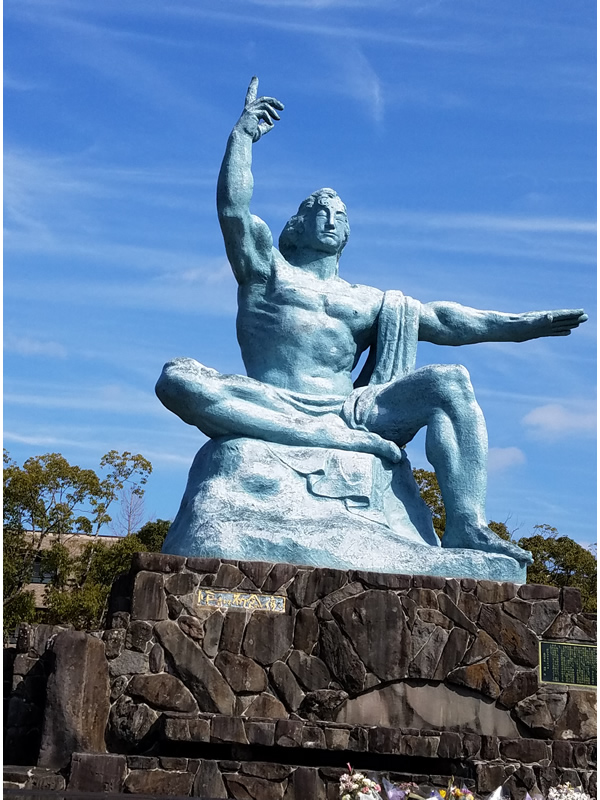
There is also a fountain there which is an offering of water to the victims of the atomic bomb and a prayer for the repose of their souls.

Our last stop was Glover Gardens, home of a Scots businessman who lived in Nagasaki during the late Edo period (which was 1603- 1868) and early Mejii Restoration (which began in 1868), thus during the early and mid 1800s. The gardens have great views over the sea and contain the transplanted period houses of foreign traders who lived on Daijima Island, a man made island in Nagasaki Bay, the only place in Japan where foreigners where permitted until Perry "invaded" Japan.

Although this picture does not show it too much, Nagasaki is sometimes referred to as the San Francisco of Japan. The passage into the harbor is narrow and has high hills on both sides with houses on them.
Not to be outdone by Kagoshima, our send off in Nagasaki was one of the famous Japanese drum bands. The rhythm exhibited was extraordinary as well as the continuous physical effort needed to hit those drums.
We had two cold days in Osaka and two beautiful tourist days in Kagoshima and Nagasaki, but I fear that it will be below freezing again until at least Shanghai...
Although this tells more about Japan than Nagasaki I want to add this here. The guide that we had in Nagasaki, although born in Japan, is not a Japanese citizen because his parents are American. They have been here for 40 years. He married a Japanese and their children can decide at 21 whether they want to be American or Japanese. There is no dual ascitizenship.
At home the guide said that he learned English, but at 5 when he went to elementary school he was immersed not only in the Japanese language, but the culture. In elementary school, he came home one day and asked his mother for a pail, water, and a brush to clean off some graffiti which a classmate had done. His mother said, well if X did it then X needs to clean it up. “No,” her son said, “We are all responsible.” This sense of responsibility had been engrained into him in the schools. He was sent to New York for high school and college. In the high school he was amazed to see janitors. In Japan, starting when they first enter school, the students are responsible for cleaning the school including the toilets. A good impetus to not litter… After college he came back to Japan.
It is with sadness that I leave Japan, there was so much more to see at all our stops. And there is much more that I could say.
